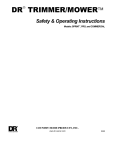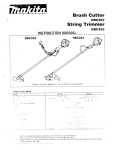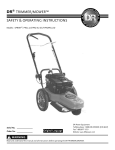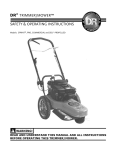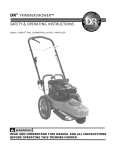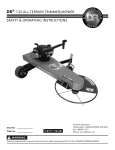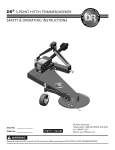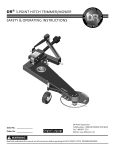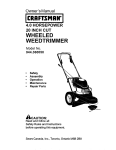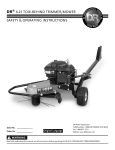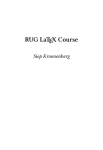Download DR Manual-Start - Push Operating instructions
Transcript
® DR TRIMMER/MOWER™ Assembly & Operating Instructions Model: • SPRINT® Please read these instructions and the Engine Manufacturer's Owner's Manual before you assemble and use your DR® TRIMMER/MOWER™. And congratulations on your purchase of a new DR® TRIMMER/MOWER™! We have done our utmost to ensure that your DR® will be one of the most trouble-free and satisfying pieces of equipment you have ever owned. Please let us know of any questions or problems you may have. We want to answer or correct them as quickly as possible. (When you do call or write, please have your serial number and/or order number handy—it will speed things up!) We also hope to hear from you on how much you like your new helper. And please tell your friends about your new DR® TRIMMER/ MOWER™. Having DR® Owners spread the word about our products and our way of doing business is the best advertising we can have, and it's the best way to help us provide even better service in the years to come. Thanks once again! for all of us at... COUNTRY HOME PRODUCTS® DR® TRIMMER/MOWER™ Assembly & Operating Instructions i ii DR® TRIMMER/MOWER™ Assembly & Operating Instructions Table of Contents SAFETY INSTRUCTIONS ...............................................................................................................................................1 Dress Appropriately.........................................................................................................................................................1 Preparation.......................................................................................................................................................................1 Operating the Machine Safely .........................................................................................................................................1 Safety with Gas-Powered Machines ................................................................................................................................2 Warning to All California and Other Users .....................................................................................................................2 TRIMMER PARTS & COMPONENTS ..........................................................................................................................3 ASSEMBLY COMPONENTS...........................................................................................................................................4 ASSEMBLY ........................................................................................................................................................................5 CONTROLS & FEATURES ...........................................................................................................................................10 STARTING & OPERATING ..........................................................................................................................................11 Electric-Starting.............................................................................................................................................................11 Manual-Starting .............................................................................................................................................................11 Stopping the Engine.......................................................................................................................................................12 Engaging the Trimmer Head..........................................................................................................................................12 Stopping the Cords from Spinning ................................................................................................................................12 Cutting Cords.................................................................................................................................................................13 TRIMMING AND MOWING METHODS....................................................................................................................14 Obstacles........................................................................................................................................................................14 Mow-Ball™ Support.......................................................................................................................................................14 Cutting Cords.................................................................................................................................................................14 Adjusting the Cutting Height .........................................................................................................................................16 Wagner Anti-Wrap Device ............................................................................................................................................17 Heavy Growth................................................................................................................................................................18 Wet Conditions ..............................................................................................................................................................18 Very Dry Conditions......................................................................................................................................................18 Slopes.............................................................................................................................................................................18 Windrows.......................................................................................................................................................................19 Firebreaks ......................................................................................................................................................................19 End-of-Season Garden Clean-Up ..................................................................................................................................19 MAINTENANCE..............................................................................................................................................................20 Regular Maintenance .....................................................................................................................................................20 Battery Care (Electric-Starting models only).................................................................................................................21 To Remove the Mow-Ball™ Support Assembly ............................................................................................................ 22 To Reassemble the Mow-Ball™ Support Assembly.......................................................................................................23 To Partially Lower the Bearing Housing Assembly (to remove debris)........................................................................24 To Check the Bearing Housing Assembly for Damage .................................................................................................24 To Remove and Replace the Bearing Housing Assembly .............................................................................................25 To Replace the Belt .......................................................................................................................................................26 To Adjust the Belt Tension Using the Trimmer Control Cable .....................................................................................27 TROUBLESHOOTING ...................................................................................................................................................28 PARTS LIST .....................................................................................................................................................................32 SCHEMATIC DRAWING ..............................................................................................................................................33 DAILY CHECKLIST FOR THE DR® TRIMMER/MOWER™ ........................................................... BACK COVER DR® TRIMMER/MOWER™ Assembly & Operating Instructions iii Safety Instructions We want you to enjoy years of productive use from your DR® TRIMMER/MOWER™. We don't want you to get injured, so please take a few moments to read the following guidelines for safely operating your new machine. Dress Appropriately · Always wear protective goggles (provided with your DR® TRIMMER/MOWER™) while mowing, to protect your eyes from possible thrown objects. · Wear shoes with non-slip treads when using your DR® TRIMMER/MOWER™. If you have safety shoes, we recommend wearing them. Do not use the machine while barefoot or wearing open sandals. · Wear long pants while trimming, and avoid wearing loose clothing or jewelry that might get caught on the mower's moving parts. · Use ear muffs or ear plugs to protect your valuable hearing. Preparation · Read these Assembly & Operating Instructions and the Engine Manufacturer's Owner's Manual before you use the DR® TRIMMER/MOWER™. Become familiar with the controls, engine and service recommendations to ensure the best performance from your machine. · Inspect the area you'll be working in for hidden objects such as large rocks, logs, rope, wire, garden tools, etc., and remove these obstacles before mowing. Do not attempt to mow over obstacles as this could damage the machine and cause injury. Operating the Machine Safely · Only use the DR® TRIMMER/MOWER™ for trimming and mowing grass, weeds, and other growth as specified in this manual. · Use only manufacturer-recommended replacement parts and accessories. · Never bend, cut, fit, weld, or alter the DR® TRIMMER/MOWER™ in any way. Modifications to your machine could cause personal injuries and property damage, and may void your warranty. · ALWAYS shut off the engine and remove the spark plug wire prior to making any adjustments to the machine. If you have to stop to remove grass or debris from the underside of the deck, ALWAYS disconnect the spark plug wire first. · The exhaust area on the engine becomes very hot. Allow the engine to cool before doing maintenance or making adjustments. · When operating over uneven terrain and slopes, use EXTREME CAUTION and ensure solid and firm footing at all times. · Use extra caution when mowing in wet, slippery conditions. · Turn off the engine whenever you leave the operating position. Never leave the engine running when refueling, changing cords or working on the machine. DR® TRIMMER/MOWER™ Assembly & Operating Instructions 1 · As with any trimmer, the tips of the cutting cords on the DR® TRIMMER/MOWER™ can throw sticks, small stones, gravel, and bits of debris for long distances at great velocity. The faster the cutting cords are spinning, the farther debris may be thrown. Do not move over loose materials such as gravel or mulch with the trimmer head spinning. Doing so could cause personal injury or property damage from thrown objects. · Never allow children or animals near the work area. Keep at least 50 feet clear of bystanders, and always turn the machine off when someone approaches to avoid causing injury from thrown objects. · Never allow children or people unfamiliar with these instructions to use the DR® TRIMMER/ MOWER™. · Be cautious when using your DR® TRIMMER/MOWER™ around fencing, wires, ropes, and hoses. It is possible that these and other debris can become wound around the shaft of the machine, potentially damaging the bearings or injuring the operator. · · · · Use the machine only in daylight or good artificial light. Never operate the machine with a damaged shield or without the shield in place. Do not operate the machine when under the influence of alcohol or medication. Watch for traffic when mowing near roadways. Safety with Gas-Powered Machines · Do not run the engine in an enclosed area or without proper ventilation. · Store all fuel in containers specifically designed for this purpose. Plastic containers are more likely to prevent sediment and condensation problems. · Refuel outdoors only, and do not smoke while refueling or operating the machine. · If gas is spilled, do not attempt to start the engine. Move the machine away from the area of the spill and avoid creating any source of ignition until the gas vapors have dissipated. Wipe up any spilled fuel to prevent a fire hazard, and properly dispose of the waste. · Allow the engine to cool completely before storing in any enclosure. Never store the machine with gas in the tank near an open flame or spark. · Do not change the engine governor settings or modify the engine speed. · Some state and local regulations require the use of a spark arrester on gas powered engines. Contact your local fire marshal or forest service for specific information pertaining to your area. If you are required to use a spark arrester, please contact one of our Customer Service Representatives for assistance in obtaining and installing one. Warning to All California and Other Users Under California law, and the laws of some other states, you are not permitted to operate an internal combustion engine using hydrocarbon fuels without an engine spark arrester. All DR® TRIMMER/ MOWERS™ shipped to California and Washington state are provided with spark arresters. Failure of the owner/operator to maintain this equipment in compliance with state regulations is a misdemeanor under California law and may be in violation of other state and/or federal regulations. Contact your local fire marshal or forest service for specific information in your area. 2 DR® TRIMMER/MOWER™ Assembly & Operating Instructions Trimmer Parts & Components The following parts and assembly components should be in your DR® TRIMMER/MOWER™ package. Please check your shipping box(es) and parts package(s) for the items listed below. If your shipment is incomplete or if you have any questions, please call us TOLL-FREE 1(800)DROWNER (376-9637). Assembly Components: 1—Upper Handlebar [#117761] 1—Lower Handlebar [#117741] 1—Axle [#139471] 1—Rubber Stone Guard [#139461] 1—Acrylic Shield Assembly [#120521] 2—Wheels [#121781] Parts Bag Contents: 2—Wheel Retainer Rings [#119551] 2—Handlebar Knobs [#118181] 2—Stone Guard Clamps [#131031] 2—Handlebar Bolts 1/4"-20 x 1-1/2" [#114611] 4—5/16" Washers [#121691] 4—Lock Nuts 5/16"-18 [#110761] 2—Set Screws 1/4"-20 Square Head [#120161] 6—Slotted Hex Head Bolts 10-24 x 5/8" [#114781] 6—Lock Nuts 10-24 [#118731] 2—U-Bolts [#114851] 1—Additional Cutting Height Adjustment Disk [#116201] 1—Spare Orange Bearing Housing Plug [#119101] Please refer to Figure 1 on the next page when preparing to assemble your DR® TRIMMER/MOWER™. We recommend laying the parts out in sets, as we have drawn them, before assembly. Please Note: Some of the photos in this manual show a different model than your trimmer. DR® TRIMMER/MOWER™ Assembly & Operating Instructions 3 Assembly Components Figure 1 4 DR® TRIMMER/MOWER™ Assembly & Operating Instructions Assembly WARNING: Do not attempt to start the engine until all assembly steps are complete, and you have ADDED GAS AND OIL to the engine. Please Note: Your trimmer may look slightly different than some of the photos shown in this manual. Tools & Supplies Needed: • flat head screwdriver • 1/2" and 3/8" wrenches, adjustable wrench, or socket set • pliers • SAE30 HD (High Detergent) motor oil • funnel (preferably with filter) • unleaded gasoline WARNING! THIS MACHINE IS SHIPPED WITHOUT OIL! TRACES OF OIL MAY BE LEFT IN THE RESERVOIR FROM FACTORY TESTING, BUT YOU MUST ADD THE RECOMMENDED AMOUNT OF OIL BEFORE STARTING THE ENGINE. Step 1: Install the Axle and Wheels 1. Turn the orange housing upside down to access the underside. Leave the front piece of Styrofoam in place (Figure 2). 2. Mount one wheel on the axle with the open portion of the hub facing in toward the frame (Figure 3). 3. Mount the retaining ring so it is flush with the end of the axle, and tighten the set screw (Figure 4). Figure 2 Figure 3 DR® TRIMMER/MOWER™ Assembly & Operating Instructions Figure 4 5 4. Insert the axle through the hole in the bushing in the side of the housing (Figure 5). Push the axle through both axle holes in the frame (Figure 5). Be sure the axle is over the black control cable. 5. Mount the other wheel with the open portion of the hub facing in toward the frame. Mount the retaining ring so it is flush with the axle and tighten the set screw (Figure 6). Figure 5 Figure 6 Step 2: Attach the Rubber Stone Guard 1. Mount the two black clamps on the rubber stone guard. With the clamp on the inside of the frame, insert the screws from the outside of the frame facing in, add the lock nuts and tighten them (Figure 7). Step 3: Set the Machine Upright Note: Be careful not to kink, twist or stretch the control cables. 1. Remove the front end of the Styrofoam packing. 2. Stand at one side of the machine, hold one wheel with one hand, and the nose of the Figure 7 machine with the other. Lift the front-end of the machine up and over until the Mow-Ball™ Support is resting on the ground and the machine is upright (most of the weight is on the wheels during this maneuver). 3. Being careful of the cables, bring the upper handlebar up and over the front end of the machine. Let it rest there. Caution: DO NOT add gas or oil to the engine at this time. 6 DR® TRIMMER/MOWER™ Assembly & Operating Instructions Step 4: Install the Handlebars A) Lower Handlebar Note: There are 2 U-bolts, 4 washers, and 4 lock nuts in your parts bag that will be needed for the lower handlebar assembly. 1. With the control cables on the inside of the handlebars, position the lower handlebar over the bolt holes in the trimmer frame (Figure 8). 2. Mount one of the U-bolts through the hole in the frame and handlebar from the inside facing out (Figure 8). Repeat on the other side. Figure 8 Note: Make sure the black control cable that runs along the right underside of the frame is not beneath the U-bolt. 3. Mount the washers and nuts and snug them on both sides—don't tighten them yet. Position the lower handlebar so the bolts are in the middle of the slotted notch on each side. This is the average height needed by most users. Tighten the nuts securely. After you install the upper handlebar you'll be able to judge whether you need to adjust the height. B) Upper Handlebar 1. Making sure the control cables are over the lower handlebar, position the upper handlebar outside the lower handlebar (Figure 9). The ends of the upper handlebar are cupped halfcircles and fit on the outside of the lower handlebar (inset). With the holes aligned, insert one of the two round-headed 1-1/2" handlebar bolts from the inside facing out. 2. Secure the bolt with one of the large black handlebar knobs on the outside of the handlebar. Repeat on the opposite side. The height of the handlebar depends on many factors for each individual. However, it is crucial to find a height that allows the Mow-Ball™ Support to glide along the ground and remain balanced without the operator having to push down or pull up on the handlebars. At the proper height, your hands should rest at a comfortable level and the front end should roll easily on the Mow-Ball™ Support. Figure 9 DR® TRIMMER/MOWER™ Assembly & Operating Instructions 7 To adjust the height of the handlebars, loosen the lock nuts on the U-bolts. Push the handlebars forward for more height, backward for less. Then tighten the nuts securely. Step 5: Attach the Acrylic Engine Shield Use the four remaining sets of 5/8" long bolts and lock nuts to attach the acrylic engine shield. We have found it's easiest to tip the machine back on its handlebars in order to reach the underside. 1. Position the shield on the frame in front of the engine (Figure 10) with the bend at the top facing the handlebars. 2. Insert the bolts from the outside facing in, screw on the nuts and tighten (Figure 10). Step 6: Add Oil and Gas Figure 10 WARNING!: You must add oil before starting the engine. There may be 1 to 2 ounces of oil left in your machine from factory testing, but you still need to fill the reservoir. Check the dipstick while adding oil to avoid over filling. Please refer to your Engine Manufacturer's Owner's Manual and put the recommended amount of engine oil in the oil fill. Use SAE30 High Detergent oil. Fill the oil to the amount indicated on the dipstick. Do not overfill (Figure 11). Reminder: To avoid confusion, we recommend leaving the caps on the fuel and oil fills until you are ready to pour either gasoline or oil into the correct fill. Fill the gas tank to within 1/4 inch of the top with fresh, unleaded gas. (See your engine manual for more detailed fuel recommendations.) Figure 11 Caution: Once you have added the oil and gas, avoid tipping the trimmer back on its handlebars. Doing so will cause the cylinder to fill with oil. If you need to reach the underside of the trimmer, drain the oil and gas first, or set the machine up on a workbench. 8 DR® TRIMMER/MOWER™ Assembly & Operating Instructions Step 9: Connect the Battery Wires (Electric-Starting models only) To prevent the battery from discharging during shipment, all electric-starting trimmers are shipped with the black, negative battery wire disconnected. Connect the two black wires by pushing the plastic ends together (Figure 12). See the red wires for comparison. The wires are located on the left front side when standing in the operator's position. Figure 12 DR® TRIMMER/MOWER™ Assembly & Operating Instructions 9 Controls & Features Please Note: Manual-Starting Model shown. Figure 13 10 DR® TRIMMER/MOWER™ Assembly & Operating Instructions Starting & Operating WARNING! THIS MACHINE IS SHIPPED WITHOUT OIL! TRACES OF OIL MAY BE LEFT IN THE RESERVOIR FROM FACTORY TESTING, BUT YOU MUST ADD THE RECOMMENDED AMOUNT OF OIL BEFORE STARTING THE ENGINE. Please Note: Manual-Starting model is pictured below. Electric-Starting 1. Push the throttle control lever on the right side of the handlebar (Figure 13) all the way forward to the START position. 2. Prime the engine. Make sure you completely cover the air hole on the primer bulb (Figure 14). Push the black primer bulb in and hold it for three seconds, then completely release it for three seconds (making sure you uncover the air hole). Repeat three to four more times. Note: Priming is usually unnecessary when restarting a warm engine. In cool weather priming may need to be repeated. 3. Turn the key to the START position until the engine starts, then release. The key will snap back to the RUN position (Figure 14). Manual-Starting Can be used with both Manual- and Electric-Starting models. 1. Push the throttle control lever on the right side of the handlebar (Figure 13) all the way forward to the START position. 2. Prime the engine. Make sure you completely cover the air hole on the primer bulb (Figure 14). Push the black primer bulb in and hold it for three seconds, then completely release it for three seconds (making sure you uncover the air hole). Repeat three to four more times. Note: Priming is usually unnecessary when restarting a warm engine. In cool weather priming may need to be repeated. 3. Grasp the recoil starter handle (Figure 13), and slowly pull until resistance is felt. Next, pull the cord rapidly to overcome compression, prevent a kickback and start the engine. One or two pulls usually starts the engine, but it may be necessary to repeat the priming. Figure 14 DR® TRIMMER/MOWER™ Assembly & Operating Instructions 11 Stopping the Engine Move the throttle lever back to the STOP position (Figure 13). Note that on Electric-Starting Models the key does not stop the engine. The key has a pressure lock that prevents it from vibrating loose during operation. If you wish to remove the key, push it in and then quickly and firmly pull it out. If the key is difficult to remove, spray FLUID FILM® or a comparable lubricant into the key hole. Engaging the Trimmer Head Bring the trimmer head control bar (Figure 13) toward you and grip it together with the handlebar. Keep holding the trimmer head control bar to the handlebar. The cutting cords will now be rotating and will continue to rotate until you release the trimmer head control bar. Stopping the Cords from Spinning Release the trimmer head control bar from the handlebar. The trimmer head will stop spinning while the engine continues to run. If the cutting cords keep spinning after the trimmer head control bar is released, you may need to adjust the trimmer control cable. (See page 27.) 12 DR® TRIMMER/MOWER™ Assembly & Operating Instructions Cutting Cords WARNING: Turn the engine off when installing or changing cutting cords. Two thicknesses of cutting cord ship with your DR® TRIMMER/MOWER™: Heavy-duty (130 mil) Orange and Extra Heavy-duty (155 mil) Green. Figure 15 shows how the cords are installed at the factory. Notice how the cords are installed before you replace them. Note: Before trimming, always spin new cords for a few seconds so they pull tight and set. Because conditions and vegetation vary so much, experiment with various combinations of cord weight and installation methods in order to discover what works best for your particular mowing and trimming situations. Here are a couple of things to keep in mind: Figure 15 · If you buy cutting cord in rolls, cut it in 21" lengths. · Store your cutting cord in a plastic bag with a damp sponge or rag. This will help retain moisture and keep the cords more pliable. Please see page 15 for additional cutting cord installation methods and tips for getting the best performance from your cutting cord. DR® TRIMMER/MOWER™ Assembly & Operating Instructions 13 Trimming and Mowing Methods Note: The cutting cords cut one to two inches outside of the wheel width. Many owners like to mow easy, open areas with their regular riding or walk-behind mower, then finish trimming all the odd and hard-to-reach spots with the DR® TRIMMER/MOWER™. The DR® TRIMMER/MOWER™ discharges cut material to the right. Always try to cut and trim with the uncut tall grass or weeds at the left (Figure 16). Suggestion: For the neatest F appearance, do your trimming first, Figure 16 discharging clippings away from borders and shrubs, then do your mowing. Obstacles · Always check your work area before trimming and remove any debris that might tangle or damage the machine. · If you do run into debris and the trimmer gets tangled, turn off the engine and disconnect the spark plug wire before attempting to untangle it. · DO NOT run the machine over gravel driveways or over loose stones or mulches with the trimmer head spinning. The machine's power can easily throw stones, sticks and other debris at great velocity, which could cause personal injury or property damage. Mow-Ball™ Support Allow the front end of the machine to rest lightly on the Mow-Ball™ Support as you are trimming. The Mow-Ball™ Support should glide on the ground as you maneuver the machine. In order to achieve the best and smoothest cut, do not lift up on the handlebar while operating your DR® TRIMMER/MOWER™. Lifting the handlebar causes weight to be forced down on the MowBall™ Support. This uses more energy, slows down the cutting, and produces a less than satisfactory cut. Ideally, the Mow-Ball™ Support should rest lightly on the ground while the wheels balance most of the weight of the machine. If needed, use slight downward pressure on the handlebar to prevent the Mow-Ball™ Support from digging into the ground. Cutting Cords The best trimming performance will usually come from using the smallest diameter cord that is still capable of cutting the material at hand, combined with the fastest engine speed. When more power is needed for thicker growth such as berry canes, brambles, thistles or ragweed, you may want to use the Extra Heavy-Duty Green (155 mil) cord in combination with the highest engine speed. 14 DR® TRIMMER/MOWER™ Assembly & Operating Instructions If Cords Slip There are several options for installing the cutting cords. Experimenting in different conditions with different cutting cords is a good way to find the best method. Below are some suggestions: Figure 17 · When using the standard installation method, wrap the cutting cord through the middle loop twice (the thicker, green cord is stiff, but it can be done) as shown in Figure 17 . This will help prevent the cords from slipping. · You can also try the method illustrated in Figure 18, especially for the green, 155 mil cord. This not only holds the cord tight, but also helps the cords cut better in larger diameter, tough and woody growth. · Another method is shown in Figure 19. · You can also try a method opposite of that illustrated in Figure 19. Push the cord ends IN through the two end holes in the trimmer head plate. The bottom of the U formed by the cord Figure 18 should be toward the outside. Next, pull the two ends back through the middle hole, then UNDER the bottom of the U and pull them tight. Figure 19 Be careful not to move too fast through thick growth. If there are woody weeds in the material being cut, the cutting cords may wrap around the stalks they cannot cut and pull away from the trimmer head. If the cutting cords can't cut quickly, they may tear from the machine. Ease the tips into heavy growth. F Reminder: The tips of the cutting cords do the cutting. DR® TRIMMER/MOWER™ Assembly & Operating Instructions 15 Adjusting the Cutting Height One cutting height adjustment disk is already installed on your machine, just above the Mow-Ball™ Support. An additional disk is included in your product package, but you can order more. We recommend you try trimming with one disk before experimenting with additional disks. The cords will cut approximately 1-1/2" to 2" off the ground with one disk installed. If the cut is too low or if you're cutting very tall or heavy grass, you may want to try using an additional disk. Tool Needed: • Phillips head screwdriver Caution: An improper installation may cause damage to the bearings. Please follow these directions carefully. Caution: Do not tip the machine all the way back on its handlebars unless you first drain the gas and oil. WARNING: Before performing any maintenance procedures, the engine should be stopped and the spark plug wire disconnected. 1. Remove the orange vinyl plug from the bearing housing's outer shaft (Figure 20). 2. Insert a screwdriver into the hole (Figure 20) and rotate the Mow-Ball™ Support until the screwdriver fits in the second hole in the inner shaft, locking it in place. Figure 21 Figure 20 3. With your hands, turn the Mow-Ball™ Support assembly counterclockwise with your hands until it completely unscrews from the bearing housing (Figure 21). 16 DR® TRIMMER/MOWER™ Assembly & Operating Instructions 4. Reassemble the components in the order shown in Figure 22, adding the additional cutting height disk above or below the one already installed. • Be sure bearing shield washer is beveled side up. • Be sure to align the notches in the cutting height disks and the Mow-Ball™ Support before completing assembly. • Check the head of the Mow-Ball™ Support bolt. It should sit in the groove (square washer) at the bottom of the MowBall™ Support. 5. Keeping the bearing housing locked with the screwdriver, mount the Mow-Ball™ Support assembly. Hold the bolt in place with one finger and turn the assembly clockwise onto the bearing housing until it's finger tight. 6. Spin the Mow-Ball™ Support to be sure the anti-wrap device does not hit the trimmer head plate. There should be about 1/16" to 1/8" of clearance between the top of the flat plate and the end of the anti-wrap bracket. There will be some resistance as you turn the trimmer head because of the belt and pulley. 7. IMPORTANT! Return the orange vinyl plug to the bearing housing. This will keep out dirt and debris and ensure the long life of the bearings. Do not put oil or Figure 22 grease in the hole. The sealed bearings do not need lubricant. It is possible to use up to three cutting height adjustment disks. Using a third disk will also require purchase of a longer bolt (Part #114641). Wagner Anti-Wrap Device The Wagner Anti-Wrap Device was designed to reduce the amount of grass wrapping around the bearing housing shaft. It consists of the trimmer head plate, which has a vane welded to the shaft, and a bracket that fits around the shaft (Figure 23). To remove the Anti-Wrap Device bracket: 1. Follow the instructions for removing the Mow-Ball™ Support on page 22. 2. Remove the front bearing housing bolt which mounts the upper part of the bracket to the frame (Figure 23). 3. Slide the bracket off the bearing housing. You may need to tap the bracket to get it off. Figure 23 Note: When remounting the Anti-Wrap Device there should be about 1/8" clearance between the finger and the vane. Bend the finger to adjust as needed. DR® TRIMMER/MOWER™ Assembly & Operating Instructions 17 Heavy Growth Take your time in heavy growth. If the machine can't do it all in one pass, overlap half of the cutting swath. If the grass is very thick and heavy, try raising the trimmer head off the ground a few inches by pushing down on the handlebar. Cut the material at this height, and then make a second pass with the Mow-Ball™ Support on the ground (Figure 24). EASE the DR® TRIMMER/MOWER™ into denser growth. If the material is too tough or woody and can't be cut, the cutting cords will wrap around it, wear down or even break off. Figure 24 Sometimes, growth is so heavy that it can't be mowed in rows. A back and forth "vacuum cleaner" motion often works better when tackling really tough material. Wet Conditions Because there is no housing to restrict the flow of cut material, you can use your DR® TRIMMER/ MOWER™ to mow wet or heavy growth. The DR® can also be used in damp conditions, such as after a rain or in the early morning dew, without clogging or stalling. Very Dry Conditions When trimming and mowing in very dry conditions, be extra cautious of cut grass, chaff, weeds, seeds, etc., accumulating on the engine, especially around the recoil-start housing and engine cooling fins. Remove debris frequently to prevent engine overheating and damage (Figure 25). Please see the Engine Manufacturer's Owner's Manual for more detailed information on cleaning the air intake and cooling system on the engine. Slopes Figure 25 You can trim and mow on slopes up to 20 degrees. Continuous use on slopes steeper than 20 degrees may deprive the engine of adequate lubrication and damage components. 18 DR® TRIMMER/MOWER™ Assembly & Operating Instructions Windrows The DR® TRIMMER/MOWER'S cutting cords cut even tall grass in just one pass, so you can collect clippings and leaves for mulch. The machine ejects cut material to its right, so you can use it like a lawn broom to make windrows for easy raking (Figure 26). Firebreaks Use the DR® as a labor-saving tool to cut material when creating firebreaks. End-of-Season Garden Clean-Up The DR® is perfect for cutting down spent perennials, annuals and wildflowers, saving you hours of dead-heading and pruning by hand. Figure 26 DR® TRIMMER/MOWER™ Assembly & Operating Instructions 19 Maintenance For Engine Maintenance, Please Refer to the Engine Manufacturer's Owner's Manual. IMPORTANT: Because of the extreme conditions the DR® TRIMMER/MOWER™ is often used in, air filters and oil should be changed more frequently than is recommended in your Engine Manufacturer's Owner's Manual. Please follow these recommendations: Paper Air Cartridge: Should be replaced every 25 hours of operation. Oil: Should be drained and replaced every 25 hours of operation. Regular Maintenance Regular maintenance will ensure the best performance and long life of your machine. Below is a list of recommended maintenance procedures. WARNING: Always allow the engine to cool completely and remove the spark plug wire before performing any maintenance procedures. Caution: Do not tip the trimmer back on its handlebar to access the underside unless you first drain the gas and oil. · Clean any debris from the top and bottom of the machine, cylinder head fins, blower housing, finger guard, and muffler areas with a brush or rag. · · · · · Replace the air filter(s). Replace the spark plug. Check the Mow-Ball™ Support assembly and clean out any debris wrapped around the shaft. Drop the bearing housing and clean out any debris. Check for burrs on the pulley. Lubricate the engine throttle cable, trimmer control cable, and idler pulley with FLUID FILM® or a similar lubricant. · Check the Mow-Ball™ Support and cutting height adjustment disks for wear, and replace them if necessary. · Replace broken or frayed cutting cords. · Check the belt for fraying or stretching. Replace it if necessary. · Check the bolts and nuts on the bearing housing assembly. If they are loose, tighten them with a 1/2" wrench or socket. Check occasionally throughout the season to be sure they're secure. 20 DR® TRIMMER/MOWER™ Assembly & Operating Instructions Battery Care (Electric-Starting models only) Proper care can extend the life of a battery. Follow these recommendations to ensure your battery's best performance and long life: · Do not continue to crank the engine if the battery is low. · Try to keep the battery at full charge to maximize its life. If the machine is not in use, the battery should be charged every three months. · Store an unused battery in a dry area that does not freeze. · Do not charge an already charged battery. In theory, our battery cannot be overcharged with a trickle charger; however, when a battery is fully charged and the charger is still on, it generates heat that could be harmful to the battery. Automobile batteries last for years because they are recharged every time you drive your car— usually on a daily basis. An Electric-Starting DR® TRIMMER/MOWER™ will recharge its battery while you operate it. However, if you run your DR® infrequently or let it sit during the off-season without recharging, the battery life will be dramatically shortened. If the battery loses its charge, use the DR® Battery Charger or other trickle charger to recharge it. The charger should have an output of 12 Volts at 1-2 amps. · At 1 amp the battery may need to be charged for as long as 48 hours. · At 2 amps the battery may need to be charged for as long as 24 hours. Note: Using the recoil starter and then running the engine will not recharge a dead battery. To Connect the Battery Charger 1. Detach the two battery wires going to the wiring harness on your DR® TRIMMER/MOWER™. 2. Next, attach the black (-) battery charger wire to the black (-) wire on the battery. Then attach the red (+) battery charger wire to the red (+) wire on the battery. 3. Plug the battery charger into an outlet. 4. When the battery is charged, disconnect the charger from the battery before unplugging it from the outlet. Battery Troubleshooting Symptoms of a battery needing a charge: · The engine won't start with the key but will start with the recoil starter. · A whirring noise coming from the starter. · A grinding noise coming from the starter. · No noise at all. What to do: · Check that the battery is fully charged. A fully charged battery should read 12 volts under load. Manually start the engine and then put the tester on the battery. If you need to charge the battery, follow the directions above. · Check all cable connections. DR® TRIMMER/MOWER™ Assembly & Operating Instructions 21 · · The wiring harness consists of a set of wires that lead from the ignition switch to the battery. Disconnect and reconnect the battery wires (black to black and red to red) and check the wire connections at the key switch. Call one of our Customer Service Representatives TOLL-FREE 1(800)DR-OWNER(376-9637) for assistance. To Remove the Mow-Ball™ Support Assembly WARNING: Before performing any maintenance procedures, the engine should be stopped and the spark plug wire disconnected. Tool Needed: • Phillips head screwdriver Set the machine on a bench if possible. Do not tip the machine all the way back on its handlebar unless you have drained the gas and oil. 1. Remove the orange vinyl plug from the bearing housing outer shaft (Figure 27). 2. Insert the screwdriver into the hole (Figure 27), and rotate the Mow-Ball™ Support until the screwdriver fits in a second hole in the inner shaft, locking it into place. 3. Turn the Mow-Ball™ Support assembly counterclockwise with your hands until it unscrews completely from the bearing housing (Figure 28). Figure 27 22 Figure 28 DR® TRIMMER/MOWER™ Assembly & Operating Instructions To Reassemble the Mow-Ball™ Support Assembly WARNING: Before performing any maintenance procedures, the engine should be stopped and the spark plug wire disconnected. Caution: An improper installation may cause damage to the bearings. Please follow these directions carefully. Tool Needed: • Phillips head screwdriver Note: If you removed and are reinstalling the Wagner Anti-Wrap Device, be sure the bracket is flush with or slightly above the bottom edge of the bearing housing shaft— not below it. 1. Reassemble the components in the order shown in Figure 29. • Be sure bearing shield washer is beveled side up. • Be sure to align the notches in the cutting height disks and the Mow-Ball™ Support before completing assembly. • Check the head of the Mow-Ball™ Support bolt. It should sit in the groove (square washer) at the bottom of the MowBall™ Support. 2. Hold the Mow-Ball™ bolt head in place with one finger and turn the Mow-Ball™ Support assembly clockwise until it's finger tight. Holding the bolt in place prevents it from turning in the groove and digging into the Mow-Ball™ Support. 3. Spin the Mow-Ball™ Support to be sure Figure 29 the anti-wrap device does not hit the trimmer head plate. There should be about 1/16" to 1/8" of clearance. There will be some resistance as you turn the trimmer head because of the belt and pulley. 4. IMPORTANT! Return the orange vinyl plug to the bearing housing. This will keep out dirt and debris and ensure the long life of the bearings. Do not put oil or grease in the hole. DR® TRIMMER/MOWER™ Assembly & Operating Instructions 23 To Partially Lower the Bearing Housing Assembly (to remove debris) WARNING: Before performing any maintenance procedures, the engine should be stopped and the spark plug wire disconnected. Tools Needed: • 1/2" socket • 1/2" wrench If possible, set the machine up on a bench. Do not tip the machine all the way back on its handlebars unless you have drained the gas and oil. 1. Remove the three bearing housing nuts (Figure 30) and carefully lower the bearing housing assembly (Figure 31) from the frame. Brush out any dirt and debris and check the pulley for burrs or dents. 2. Replace the bearing housing assembly and tighten the bolts. Note: If the belt comes off, please refer to the instructions on page 26 to ensure proper positioning. Figure 30 Figure 31 To Check the Bearing Housing Assembly for Damage WARNING: Before performing any maintenance procedures, the engine should be stopped and the spark plug wire disconnected. Tool Needed: • 1/2" wrench If the trimmer head doesn't rotate when you engage the trimmer head control bar, try the following test: 1. Leaving the Mow-Ball™ Support assembly in place, loosen and remove the three bearing housing nuts and lower the bearing housing from the frame (Figures 30 & 31). 2. Pull the belt off the pulley. 24 DR® TRIMMER/MOWER™ Assembly & Operating Instructions 3. Turn the Mow-Ball™ Support assembly by hand. It should turn freely, without resistance. If it doesn't turn freely or you hear a grinding noise, the bearings may be worn and you may need to replace the bearing housing assembly. 4. Call one of our Customer Service Representatives TOLL-FREE 1(800)DR-OWNER(376-9637) for information about replacing the bearing housing assembly. To Remove and Replace the Bearing Housing Assembly WARNING: Before performing any maintenance procedures, the engine should be stopped and the spark plug wire disconnected. Tools Needed: • 1/2" wrench • 7/16" wrench • pliers • 5/32" Allen wrench • you may also need a pulley extractor To Remove the Old Bearing Housing 1. Remove the Mow-Ball™ Support assembly. See page 22 for instructions. 2. Loosen and remove the three bearing housing nuts and lower the bearing housing from the frame (Figures 30 & 31). 3. Pull the belt off the pulley. 4. Flip the bearing housing over. 5. Slide the Wagner Anti-Wrap bracket off the bearing housing. You may need to tap it to make it slide off. 6. To remove the pulley (Figure 32), unscrew the set screw from the pulley Figure 32 with an Allen wrench. Then tap the pulley to loosen it from the shaft. Be careful not to hit the shaft, as it will expand and make the pulley harder to remove. Remove the pulley. You may need a pulley extractor. To Mount the New Bearing Housing 1. Mount the pulley on the new bearing housing, leaving the shaft recessed about 1/16". Secure with the set screw. You may want to use Loctite® 242 to keep the set screw in place. 2. Mount the belt around the bearing housing pulley. Be sure the belt is placed on the INSIDE of the belt guides and that the other end of the belt goes through the belt retainer and around the engine pulley (page 26, Figures 33 & 34). Also, be sure the belt is on the INSIDE of the idler pulley #1. 3. Set the new bearing housing assembly into place. Insert the three bearing housing bolts through the frame, and tighten the nuts (Figure 30). 4. Mount the Mow-Ball™ Support assembly. See page 23 for instructions. DR® TRIMMER/MOWER™ Assembly & Operating Instructions 25 To Replace the Belt Figure 33 shows the belt and pulley system from the underside of the machine. WARNING: Before performing any maintenance procedures, the engine should be stopped and the spark plug wire disconnected. 1. Remove the old belt. Take the new belt and loop it over the bearing housing pulley and in between the belt guides (Figures 33 & 34). 2. Put the opposite end of the belt around the engine pulley, making sure the belt is INSIDE the belt retainer and on the INSIDE of idler pulley #1 (Figures 33 & 34). Note: The Anti-Wrap Device is not shown in Figure 34. Figure 33 Figure 34 26 DR® TRIMMER/MOWER™ Assembly & Operating Instructions To Adjust the Belt Tension Using the Trimmer Control Cable If the trimmer head stops spinning when the trimmer head control bar is engaged and the machine is operating under a heavy load, the belt may be too loose and the trimmer control cable may need to be adjusted to put more tension on it. Before making any adjustments to the trimmer control cable, check that the belt is mounted on the correct side of the idler pulley (see page 26, Figure 33), and is not frayed, worn or stretched. WARNING: Before performing any maintenance procedures, the engine should be stopped and the spark plug wire disconnected. Tools Needed: • (2) 1/2" open-end or adjustable wrenches, or pliers To adjust the belt tension through the trimmer control cable (Figure 35), you may find it easier to set the trimmer up on a workbench, or, after draining the gas and oil from the engine, tip the machine back on the handlebar. 1. With wrench or pliers, loosen the nut in front of the bracket, leaving about 1/8" of space between nut and bracket (Figure 35). 2. Grip the metal end of the black cable with pliers, making sure you DO NOT pinch it. At the same time, tighten the rear nut until it is flush and snug against the bracket. The parts will then be in the same position as in step 1, but 1/8" to the right (Figure 35). If the trimmer head keeps spinning after the Figure 35 trimmer head control bar is released the belt may be too tight. Repeat the above steps, except this time loosen the rear nut, then tighten the front nut. For Engine Maintenance, Please Refer to the Engine Manufacturer's Owner's Manual. IMPORTANT: Because of the extreme conditions the DR® TRIMMER/MOWER™ is often used in, air filters and oil should be changed more frequently than is recommended in your Engine Manufacturer's Owner's Manual. Please follow these recommendations: Paper Air Cartridge: Should be replaced every 25 hours of operation. Oil: Should be drained and replaced every 25 hours of operation. DR® TRIMMER/MOWER™ Assembly & Operating Instructions 27 Troubleshooting WARNING: Before performing any maintenance procedures, the engine should be stopped and the spark plug wire disconnected. Engine won't start manually Þ Are you priming? Push the primer bulb 3 to 5 times, releasing completely each time. (Please refer to the Engine Manufacturer's Owner's Manual for engine-specific procedures.) Þ Are you using fresh, clean gas? If it’s old, change it. Use a fuel stabilizer if you keep gas longer than two weeks or so. Þ Does the engine have the right amount of clean oil? If it’s dirty, change it following the procedure in the engine manufacturer's owner's manual. Þ Is the spark plug clean? If it’s fouled or cracked, change it. If it’s oily, leave it out, hold a rag over the plug hole and pull your recoil cord several times to blow out any oil in the cylinder, then wipe off the plug and reinsert it. Þ Is the air filter clean? If it’s dirty, change it following the procedure in the Engine Manufacturer's Owner's Manual. Þ Is the throttle cable attached to the engine and moving freely? Þ If your engine still won’t start, call 1(800)DROWNER(376-9637) for advice and assistance. Engine won't start using electric-start Þ Have you checked all the items under manual start above? If not, do so now. (Please refer to the Engine Manufacturer's Owner's Manual for engine-specific procedures.) Þ Is your battery charged? Check it yourself or at a gas station. If it’s low, charge it with a 12-volt, 1.5 to 2 amp trickle charger. If you don’t use your ® DR for 45 minutes or so at a time, the battery may need to be periodically charged. See the Battery Maintenance section of this manual. Þ If your battery is charged and your DR still won’t start, call 1(800)DR-OWNER(376-9637) for advice and assistance. Engine lacks power or is not running smoothly (Please refer to the Engine Manufacturer's Owner's Manual for engine-specific procedures.) ® Þ Are you using fresh, clean gas? If it’s old, change it. Use a fuel stabilizer if you keep gas longer than two weeks or so. Þ Does your engine have the right amount of clean oil? If it’s dirty, change it following the procedure in the engine manufacturer's owner's manual. Þ Is the spark plug clean? If it’s fouled or cracked, change it. If it’s oily, leave it out, hold a rag over the plug hole and pull your recoil cord several times to blow out any oil in the cylinder, then wipe off the plug and reinsert it. 28 DR® TRIMMER/MOWER™ Assembly & Operating Instructions Engine lacks power or is not running smoothly (continued) Þ Is the air filter clean? If it’s dirty, change it following the procedure in the Engine Manufacturer's Owner's Manual. (Please refer to the Engine Manufacturer's Owner's Manual for engine-specific procedures.) Þ Is the throttle cable attached to the engine and moving freely? Þ Are the blower housing, throttle linkage and cooling fins free of debris? Clean them following the instructions in the engine manufacturer's owner's manual. Þ Are the bearing housing and trimmer head clogged with debris? Drop them and clean according to the To Partially Lower the Bearing Housing Assembly instructions in the maintenance section of this manual. Þ If your engine still lacks power, call 1(800)DROWNER(376-9637) for advice and assistance. Grass is wrapping on trimmer shaft, bearing housing and/or trimmer head ™ Þ Lift the Mow-Ball Support slightly off the ground by pushing down on the handlebar and back the machine up. This should help clear the debris. You can also turn the engine off, disconnect the spark plug and pull out any remaining material with your hands, or use a knife to cut it away. Þ Are you trying to do too much too fast? Check the tips in the section on breaking cutting cords below. Þ Any time you have to pull or cut away wrapped ® vegetation, turn off the DR and disconnect the spark plug wire. Trimmer head won't spin Þ Is the trimmer head control fully engaged? Pull the trimmer head control bar all the way back to the handlebars, then firmly push the trimmer head control lever all the way down until you hear a click. When you release it, it will spring part way back. The head will keep spinning as long as you hold back the trimmer head control bar. Þ Is your v-belt properly aligned? Check it against the diagram in the Belt section of this manual. Make sure the belt is inside the idler pulley, that the spring on the idler pulley arm is in place. Þ Is your v-belt worn or frayed? If so, replace it. Þ Are your bearings in good shape? Follow the To Check the Bearing Housing Assembly instructions in the maintenance section of this manual. Þ Are the bearing housing and trimmer head clogged with debris? Drop them and clean according to the To Partially Lower the Bearing Housing Assembly instructions in the maintenance section of this manual. DR® TRIMMER/MOWER™ Assembly & Operating Instructions 29 Trimmer head won't spin (continued) Þ If the head still will not spin, follow the procedure for To Adjust the Belt Tension Using the Trimmer Control Cable in the maintenance section of this manual. Þ If none of the above helps, call 1(800)DROWNER(376-9637) for advice and assistance. Trimmer head keeps spinning Þ Is your v-belt properly aligned? Check it against the diagram in the Belt section of this manual. Make sure the belt is inside the idler pulley, that the spring on the idler pulley is in place. Þ Is the sleeve on the trimmer head control cable clogged with debris? If so, clean it out and spray ® some FLUID FILM on the cable. Þ If the head keeps spinning when you release the trimmer head control bar, see To Adjust the Belt Tension Using the Trimmer Control Cable in the maintenance section of this manual for instructions on tightening the cable. Þ If none of the above works, call 1(800)DROWNER(376-9637) for advice and assistance. Cutting cords are breaking Þ Are your cords dry? Store cords in a plastic bag with a damp sponge or cloth to make them less prone to breaking. Þ Are you trying to do too much too fast? Ease into material to be cut; the cord tips do the work. Take small bites of tall or tough vegetation. Cut half a swath at a time, keeping the cut area to the ® discharge or right side of the DR . Go over tall material twice, the first time with the head tilted up and back, the second time with the MowBallä Support on the ground. Þ Try a lighter cord, or tying on only one cord for a faster head spin. Þ Are you hitting your cords against stone or a chain-link fence? The cords just won’t last as long when this occurs. Work on controlling the cutting pattern; with practice you’ll learn to cut closer to obstacles without hitting them. Cutting cords are pulling out Þ Are you moving too fast into tough, woody growth? If so, cords may wrap on stalks and pull out. Check the tips in the section on breaking cutting cords above. Also, try the different methods of attaching the cord shown in the Cutting Cords section of this manual. Þ Are you trying to cut material too heavy for the ® cord? The DR is designed to cut green material up to about the thickness of a pencil. 30 DR® TRIMMER/MOWER™ Assembly & Operating Instructions Mow-Ballä Support is wearing too quickly Þ Are you pushing the trimmer head down into the ® ground? The DR TRIMMER/MOWERä works best with a light touch, with the Mow-Ballä Support resting easily on the ground. Þ Are you hitting the Mow-Ballä Support against rocks, concrete driveways or other hard obstacles? Try approaching them slowly, and from different directions, to avoid unnecessary wear. For technical assistance call one of our Technical Representatives TOLL-FREE 1(800)DR-OWNER (376-9637). DR® TRIMMER/MOWER™ Assembly & Operating Instructions 31 Parts List Please Note: Reference numbers match the circled numbers on the schematic drawing. Not all parts listed appear on the drawing. Ref# 03A 04 05 06 06A 07 08 15 16 17B 20 21 22 25 Part# 117791 117741 119551 121171 121131 139471 115101 118181 127021 114411 119011 139461 131031 116201 26 28 31 377 37A 37B 43 44 45 46 46A 47 48 49 50 53 53A 54 56 57A 59 63 120521 121541 114611 111571 115831 115811 118161 121691 114651 119191 120171 125381 113091 118691 118731 121701 112391 120161 114431 114781 118641 120131 32 Description Handlebar Grip Lower Handlebar Wheel Retaining Ring ™ Plastic Mow-Ball Support ™ Aluminum Mow-Ball Support Axle Return Spring Bracket Handlebar Knobs Clutch Control Wheel Bearing Trimmer Head Plate Rubber Stone Guard Stone Guard Clamp Cutting Height Adjustment Disk Shield Assembly Bearing Shield Washer Handlebar Bolt Bolt, HHCS, 5/16" x 1-3/4" Heavy Duty Cutting Cord EXTRA Heavy Cutting Cord Key 3/16" Sq. Flat Washer 5/16" Mow-Ball Bolt Engine Pulley Set Screw 5/16"-18 Head Pulley Washer Hex Nut 5/16" Nylon Lock Nut Flat Washer (3/8" SAE) Flat Washer (3/8" USS) Set Screw (Sq HD) V-Belt Hex HD Screw 10-24 x 5/8" Elastic Stop Nut Screw, Round Head, 10-24 x 1-3/4" Ref# 65 66 67 68 69B 71 72 73A 76 Part# 110761 114741 114721 119851 119911 113071 119101 119381 121681 77B 78 79 82 83 84 85 90 90A 91 92A 93A 94A 95 96 118 140 302 302H 303 310 311 312 313 317 340 352 114661 114851 117471 139481 139491 119231 110751 113081 118111 119831 121191 117811 135101 113001 113051 114311 129311 125321 114221 117761 117621 136041 114921 115761 121781 118001 114561 Description Elastic Stop Nut 5/16"-18 Hex HD Bolt 5/16"-18 x 2" Bolt, HHCS, 3/8-24 X 1/2" Hex HD Bolt 3/8"-16 x 1 1/2" Shoulder Screw Idler Pulley #1 Vinyl Plug Belt Retainer Mow-Ball Rectangular Washer Bolt, HHCS, 5/16"-18 X 2-1/4" Handlebar U-bolt Goggles Main Frame Bushings Idler Pulley #2 Elastic Stop Nut, 3/8"-16 Electric Starter Switch Electric Starter Key Hex Head Bolt 1/4" –20 x 3/4" Switch Mounting Plate Ignition Wiring Harness Battery Clamp--Plastic Battery Neoprene Battery Pad Bail Bar Clutch Cable Spring Bearing Housing Complete Head Assembly Upper Handlebar Belt Guide Idler Arm Belt Retainer Bracket Throttle Control Lever Wheel, 14" Idler Return Spring Throttle Bolt 1/4"- 20 x 2" DR® TRIMMER/MOWER™ Assembly & Operating Instructions Schematic Drawing Figure 36 DR® TRIMMER/MOWER™ Assembly & Operating Instructions 33 Daily Checklist for the DR® TRIMMER/MOWER™ To help maintain your DR® for optimum performance, we recommend you follow this checklist each time you use it. See the appropriate section of this manual or your Engine Manufacturer's Owner's Manual for instructions. 4 GAS: Fill the gas tank with clean, fresh, unleaded gas. Be careful not to spill gas on the engine shield. Gasoline will cloud the acrylic. If gas does spill on the shield, rinse it immediately with soap and water. 4 OIL: Check the oil level and add more if necessary (add oil to the level indicated on the dip stick—do not overfill). Use SAE 30 (HD) High Detergent oil. 4 SPARK PLUG: Clean or replace the spark plug. 4 AIR FILTER: A clean air filter will mean a much easier-starting and better running engine. 4 ENGINE AIR COOLING SYSTEM: It is very important to keep the engine clean of debris. Remove grass and other built-up materials from the air intake screen, blower housing, and cooling fins regularly. A dirty engine retains heat and can cause damage to the internal engine parts. 4 BELT: Check the belt for wear, proper alignment and tension. 4 CUTTING CORDS: Replace broken or frayed cords. 4 MOW-BALL™ SUPPORT & CUTTING HEIGHT ADJUSTMENT DISKS: Check the Mow-Ball™ Support and cutting height adjustment disks for wear. Make sure the Mow-Ball™ Support and cutting height adjustment disks are lined up with the notches in the trimmer head plate. COUNTRY HOME PRODUCTS® Meigs Road, P.O. Box 25, Vergennes, Vermont 05491 1(800)DR-OWNER(376-9637) ©1999 CHP, Inc. 139171 34 CODE: 30161X DR® TRIMMER/MOWER™ Assembly & Operating Instructions








































